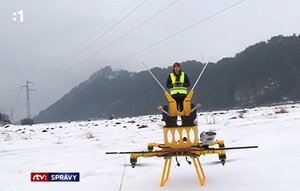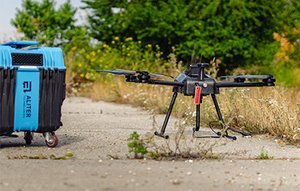Slovak drones help save animal lives
Bratislava-based experts have created a game-changing UAV technology that's attracting interest from both Australia and Canada. After years of development, they've successfully built a drone that can withstand the powerful electromagnetic fields surrounding high-voltage power lines carrying as much as 400 kV.
This enables the device to take off and get near electrical cables under current and install bird diverters without risk. Traditionally, power line maintenance involved planned outages and manual installation of diverters using ladders or bulky tools. UAV technology has revolutionized this process, allowing power companies save hundreds of thousands of euros.
The innovation from Slovak tech developers is making waves globally
The BDC drone from the Aliter Technologies portfolio was first introduced in 2017 in France and already then it gained considerable attention of the tech expert community. Most professionals will confirm having predominantly negative experience with the installation of protective elements and bird diverters. It is a financially demanding and time-consuming process. This is why experts in the field appreciate the innovative solution from Slovakia.
With the help of the Slovak UAV and a trained pilot, it is possible to install bird diverters on power lines quickly and cheaply anywhere in the entire world, even in remote locations, otherwise inaccessible using conventional installation methods.
In addition to several European countries and customers in Queensland and Tasmania, Australia, innovative Slovak UAVs from Aliter Technologies have also attracted interest from overseas customers in the US and Canada.
Drones innovate the conventional procedures while bringing considerable costs-saving
Working at heights poses an increased risk to people, so the employers have to compensate these workers better. In addition, there is a shortage of specialized professionals in the labor market, and it is more important than ever for power companies that their employees preferably devote their precious time to work activities that have direct impact on the smooth operation of the power grid.
In addition, with the conventional installation of bird diverters, any energy business would have to plan for a power outage, which complicates the entire process while making it more expensive.
The BDC drone, on the other hand, can work on power lines that are still live. It is capable of working under both moderate and fast gusts of wind and is equipped with an HD camera that facilitates its operation and control.
Drone pilots can access areas that are too dangerous, remote, or delicate for traditional installation methods. These mainly includes roads, bodies of water, swamps, steep or overgrown terrain or fields with crops. Aliter Technologies, the UAV manufacturer states that if controlled by a professional pilot, one such drone can install 150 to 300 bird diverters each day.
Slovaks have known about the challenge for years, but only now are they able to address it effectively
While energy companies and civic associations are working to reduce bird deaths, significant challenges remain, making progress slow and expensive.
Although digging the entire power grid in the ground would perhaps be ideal, this particular solution is in fact the most expensive of all.
In the long run, planting tall trees near power line poles will also help, as they naturally increase the height of flight path of birds over the power line.
What are the most common causes of bird deaths? Protected predators among the most endangered species
According to the State Nature Conservation of the Slovak Republic, over 13,000 birds die annually as a result of contact with power line poles in Slovakia alone. Their social value can be estimated at €32 million.
This problem gets particularly acute when large flocks move between natural habitats or along major migration routes. However, according to nature conservationists, collisions alone account for only 20% of the total number of deaths.
The main cause of death is the electric shock that occurs on the brackets of the electric poles. These are highly attractive locations for predators as they offer an elevated position from which the birds can observe the surroundings and wait for their prey.
Electric shock occurs when a bird simultaneously touches two wires, or the wire and a part of the bracket when landing. Most often, medium-sized, and large species of protected predators such as the peregrine falcon, the golden eagle and the common buzzard are the victims that die on the electric poles. Herons, owls, and storks are also among the species that are in danger.
Storks build their nests on the tops of poles or directly on the wires. The nests tend to get soaked during heavy rains and cause short circuits, which, in turn, ignites the nests and kills the chicks.
UAVs are proving valuable in various Slovak industries going beyond the energy sector
In agriculture, UAVs are currently deployed for targeted field spraying and livestock/animal monitoring.
In addition to optimizing the sowing and irrigation process, technologically more advanced drones use multispectral and thermal cameras to identify water deficiency in plants, chlorophyll levels, and perform soil analysis, including pest detection.
However, Aliter Technologies, the UAV manufacturer, claims that unmanned aerial vehicles could be used on a much larger scale already today. “They’re basically just flying platforms on which anything can be installed,” explains Ákos Haramia, one of the authors of the BDC drone.
For example, in Bratislava, UAVs are also used to locate and spray mosquito hatcheries or monitor sewers. However, the extensive use of drones in multiple sectors is hindered by the legislation that is lagging behind and is not yet adapted to this situation.
According to a survey conducted by Marketsandmarkets, the global agricultural drone market was worth €4.5 billion in 2023. It is expected that with the current annual growth rate of 31.5%, the market value is likely to reach €17.9 billion within 5 years.
However, national legislation and the development of autonomous systems could significantly accelerate this growth, not only in the agricultural sector.
Slovak tech experts from Aliter Technologies have demonstrated that UAVs have a wide range of applications outside the movie or defense industry – and in combination with the right technology, they can generate considerable savings in both the public and private sectors.
SORCE: Fontech
Mohlo by vás zaujať
Daily news Hospodarske noviny looked at our products that succeeded abroad.
Drones can protect birds.
Aliter Technologies is a Slovak-based tech company whose product portfolio, features drones (UAVs) not only used by institutions at home but also p...
Aliter Technologies was a part of the article about IDEB 2018 in the June issue of the month OBRANA. Furthermore, you can read in the article about...




